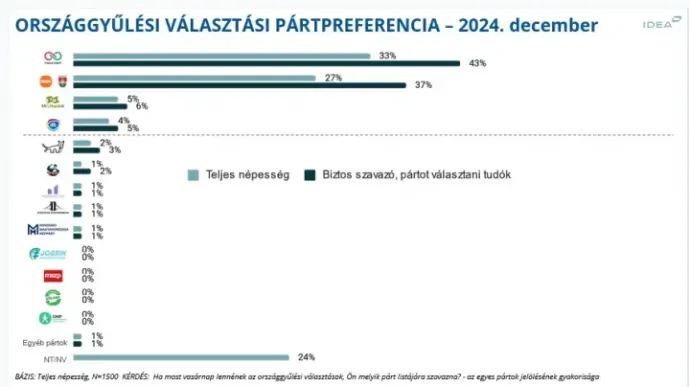Tisza Party increased its lead over Fidesz, survey shows
The Tisza Party's lead over Hungary's governing Fidesz-KDNP has increased to 6 percentage points among the total population and among those certain to vote, according to a national, representative survey conducted by IDEA Intézet (IDEA Institute) between 29 November and 6 December.
According to the survey, one third (33 percent) of the adult population would have voted for the Tisza Party in a parliamentary election in early December, while the governing parties would have received 27 percent.
IDEA reports that, taking into account the willingness to vote, 43 percent of those certain to cast a vote and able to choose a party would have voted for Péter Magyar's party in elections this Sunday, while 37 percent would have supported Fidesz-KDNP. According to IDEA's findings, if a parliamentary election had been held in Hungary between the end of October and the beginning of December, the most likely outcome would have been a four-party parliament: in addition to Fidesz-KDNP and Tisza, Mi Hazánk and DK would have reached the 5 percent threshold required among those certain to vote and able to choose a party.
IDEA writes that a significant change compared with previous surveys is that since the beginning of the year, the proportion of those with uncertain party preferences has decreased by 13 percentage points.

A previous IDEA Institute survey found that 30 percent of the domestic adult population would have voted for the Tisza Party, while support for the governing parties was 28 percent at the time. This would have translated to 41 percent for the former and 38 percent for Fidesz-KDNP among those who were likely to vote and able to choose a party.
Research Methodology
IDEA Institute collected the data for the survey between November 29 and December 6, 2024, using an on-line questionnaire. The final results are representative of the country's adult population in terms of educational background, age, gender, type of municipality of residence and region of residence. The data was collected on the entire Hungarian web and on social media, using a self-administered online questionnaire (CAWI). When weighting, the various internet and social site usage patterns were controlled, thus complementing the weighting procedures to ensure representativity. With a sample of 1,500 respondents, the margin of error of underlying distribution is ±2.3 percentage points at most.
For more quick, accurate and impartial news from and about Hungary, subscribe to the Telex English newsletter!